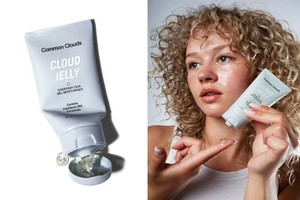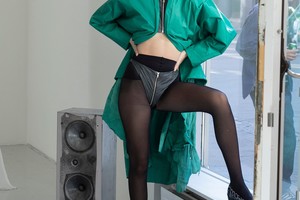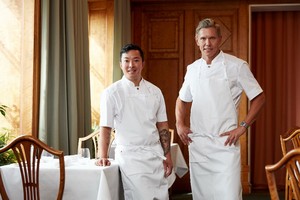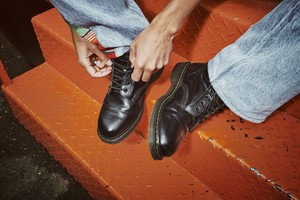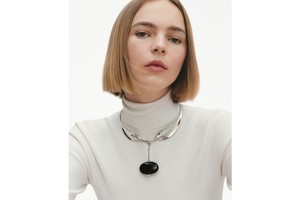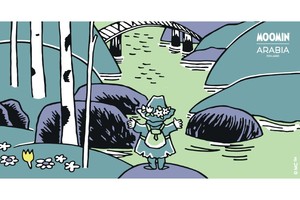"Börje - The Journey of a Legend" - Interview with Hedda Stiernstedt & Valter Skarsgård
Written by Jahwanna BerglundNovember 19th marked the world premiere of the biography tv-show “Börje- The Journey of a Legend”.
A tv-series in six episodes unfolding the early life of the Swedish hockey icon Börje Salming, played by Valter Skarsgård alongside actress Hedda Stiernstedt portraying his first wife, Margitta.
In an exclusive chat with Odalisque, the talented duo sheds light on their immersive experiences travelling back in time and bringing these characters to life.
Valter, can you tell us what drew you to the role of Börje Salming in this series? What about the character and the story resonated with you?
Meeting Börje I was sold instantly. His story is so unbelievable and amazing that I felt that I had to be a part of it. And it was such an interesting challenge to try to portray someone with the duality Börje had. Being such a nice man but also being one of the toughest hockey players.
Hedda, playing Margitta Salming, what kind of research and preparation did you do to accurately portray the life and experiences of Börje Salming's wife?
I did a lot of research, and I met with Margitta. She is such a lovely and gracious person and she showed me a lot of personal pictures. BUT she is not a public person like Börje, there isn't any documentation on her, no videos or interviews etc. As an actress That’s both good and bad. Bad because I have less to go from, but good for the same reason - I had much more artistic freedom than Valter in my portrayal. That’s both good and bad. Bad because I have less to go from, but good for the same reason - I had much more artistic freedom than Valter in my portrayal.
Valter, what was it like working closely with director Amir Chamdin, who had a personal connection with Börje Salming? How did this influence your performance in the series?
Working with Amir was fantastic. We were on the same page early on. And he was very keen on inviting me into the process from an early stage so we could form this together. On set Amir was fantastic in that he was always open to suggestions or changes but never jeopardised his vision.
Valter, could you share your experience of collaborating with cinematographer Crile Forsberg once more? How did the partnership influence the visual storytelling both in front and behind the camera?
Working with Crille again was amazing. We had such a good collaboration on our first project “Zebrarummet”. I even said to him back then, when I found out he knew Amir that he has to be part of this project. He would be perfect for it. And he was!
The cinematography is a very big part of what makes the show great.
The way the project is filmed makes it feel like you’re really back there in the 70s and 80s. It doesn’t feel like a modern project that takes place then. You get transported back and that to me was fantastic to witness as we went along.
Hedda, working with Crille Forsberg on this extended project was a new experience for you. How did the collaboration between you and the photographer influence your portrayal of the character? Did the unique approach to filming enhance your performance in any way?
Of Course the visuals are always important but when working on a period project like this it's extra important! And Crille really brought it up a notch. He even built his own lenses to get that perfect 70s feeling. As an actor it's so important to trust the photographer and I really do both professionally and privately. We were lucky to work with a team who were so very good at What they do, Crille and the costume department, the scenographers, makeup, they all helped to create something extra special. Spearheaded by our lovely director Amir Chamdin who knows that 70s visual cool style inside and out.
Hedda, can you give us some insight into the emotional depth of Margitta Salming's character and how her journey is portrayed in the series?
It was important to Amir to not make her too much of a cliche ”worried wife” character. She wants her beloved husband to be happy, and he loves to play hockey so she wants that for him. But then of course the cliches in a sport-drama are there for a reason. She IS lonely most of the time, she IS scared for Börjes life when he plays. Those things are inevitable. And she also loves to create so we get to follow her pursue her career as a designer. But that’s difficult, it's the seventies and someone has to take care of the kids, you know.
Valter, Börje Salming is a legendary figure in Sweden and NHL history. How did you balance the responsibility of representing this iconic sports personality while bringing your own interpretation to the role?
I tried to stay as true as I could without making it feel like an impersonation. I early on found my way of doing Börje who I had a very clear image of in my mind. So once we were filming it was basically automatic, because of the work we had put in before.
Hedda, the series captures a significant period in Swedish hockey and sports history. What do you think the series can teach viewers about that era and its impact on the world of hockey?
It's a time where the players were expected to fight. It was so rough! But to be honest I know nothing about hockey I just know this story haha. But Börje truly is a legend in the whole world and all legends change the game.
Valter, as an actor, what were the most challenging and rewarding aspects of taking on the role of Börje Salming, a real-life sports hero?
The most challenging by far was playing hockey. I had no idea how to skate before this! But it was of course also challenging to balance the mild nature of Börje with the toughness. But as I mentioned it was 2 years of preparation that got me ready for all of it.
Hedda, could you share any memorable moments or scenes from the series that you found particularly powerful or moving as an actor?
Yes, as I mentioned one of my favorite scenes is when she picks Börje up at the AirPort after he got hit with the skate in the face and had 400 stitches. She puts on her sunglasses to hide her tears so that he won't be put under more stress. That is so sweet, so caring. If you've seen the real photos of his face you would understand how difficult it would be to hide. After that follows the ending scene and I’m not gonna Spoil it too much but I will say that I was heavily influenced by the ending of ”The graduate” in how I chose to do the scene.
Hedda, I also spotted a maple leaf tattoo on your underarm, could you share the story behind it?
I have a few tattoos and all of them have been done at parties haha this one included. Don't try this at home kids. No but on a serious note. This project is extra special to me. We were stuck in Canada together for months and so we truly became a family. I love everyone on this project and so we decided to get matching tattoos. They were made with a stick and poke technique at a party by our makeup department after a few drinks. I was the guinea pig and did the first one.
Valter, in what ways do you feel the series captures the essence of Börje Salming's legacy, both in the world of hockey and in the hearts of fans?
We stayed very close to the true story of Börje so in my opinion it gives a great look into who he was during this time. And I think a lot of people will respect him even more after this. Knowing his story in detail just adds to the legend that everyone already knows he was.
Valter, as a final question, what was the most memorable or personally impactful moment for you during the filming of “Börje - The Journey of a Legend”?
It’s impossible for me to pick just one! There were so many. But getting to go down to Niagara Falls and walk along the bank, which is not open to the public, was literally a once in a lifetime experience.


















